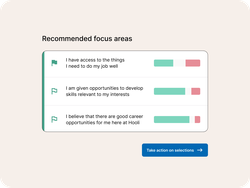
Article

If you’re familiar with Culture Amp, you’ve likely encountered the term driver analysis. It’s more commonly known as Impact on our platform and is an important part of our product, as well as a crucial process all people teams need to be familiar with to improve employee engagement. That’s why we’ve assembled the ultimate guide to driver analysis to help you understand everything you need to know about the subject.
Below is an index so you can jump specifically to a section you want to learn more about.
Driver analysis is a statistical method used to assess the relationship between different variables. This definition is a bit abstract, so let’s apply it to a real-life example.
Let’s say you want to improve employee engagement at your company. The first step is to measure current employee engagement levels. While it’s great to have a general sense of how your employees feel, this alone doesn’t tell us which factors actually contribute to engagement. This is because engagement is an outcome measure, so to understand what’s driving engagement you ask related questions like, “Have the leaders at your company communicated a vision that motivates you?” and “Are you given opportunities to develop skills relevant to your interests?”
Driver analysis then tells you which of those factors has the strongest relationship with engagement. The purpose is to identify the "drivers" of employee engagement at your company, so you can improve engagement in a more targeted, efficient way. For example, if one of your top drivers is a learning and development question, it means that people who respond most positively to that question are also likely to be the most engaged.
It’s tempting to look at the results of a survey on a question-by-question basis. If you're looking to resolve a very specific issue, this method can be very helpful in coming up with a solution. However, it won’t help you understand what's driving the broader outcomes, such as employee engagement.
Want another way to think about employee engagement driver analysis? Here’s a burrito example.

Here's how Josh Berman, Senior Customer Success Coach, and Fresia Jackson, Senior People Scientist, describe Driver Analysis.
Imagine you order a burrito. If you wanted to know if the burrito was satisfactory, you might consider a few questions like:
These questions are about how you feel about the burrito. These would be the equivalent of our employee engagement questions. Now, let's say you weren't satisfied with the burrito. If we wanted to get to why you weren't satisfied, it might be because of several reasons:
All of the above are specific questions that might answer why you felt that burrito wasn't satisfactory (aka, these are the questions in all of the non-engagement factors on Culture Amp’s engagement survey: Management, Leadership, Learning & Development). What we would want to know is which components of your burrito experience have the most significant impact on how you feel about the burrito.
For example, maybe the burrito had the wrong kind of beans, but that actually had very little to do with how you felt about the burrito as a whole because there's not a huge difference between black and pinto beans, in your opinion.
On the other hand, maybe all of the guacamole was lumped together at one end of the burrito instead of evenly distributed. That one bite of all rice and no guacamole significantly impacted your overall experience.
Given that the restaurant can't focus on fixing everything at once, if management were to take one action to most positively improve your overall satisfaction with the burrito, it would be to spread the guacamole more evenly, rather than change the kind of bean. But, if you were to include the bean or guacamole question in the "overall burrito satisfaction" category (equal to a core engagement question), you wouldn't get as clear of a picture of why you didn't like the burrito.
So why are we making a big deal about driver analysis? The short answer is that it helps you focus on improving the right things.
The longer answer is that companies – in particular, startups – move at lightning speed these days and don't have time to waste on efforts that don’t produce results quickly. A driver analysis can help you take the right actions.
For instance, when most companies see people data, they look for the headline scores (in the context of an engagement survey, that would be your overall engagement score). But those scores, whether they’re good or bad, only tell half the story. Your scores are like a balance sheet - they tell you where you are but not where you can go or how to get there.
This is why driver analysis is so important. It helps you identify which questions are scoring high or low and which questions you need to focus your attention on to drive results. This is a very powerful piece of knowledge and is crucial in determining where and how to act. Our CEO, Didier Elzinga, says this is where great leaders spend their time. Not on what their scores are but in understanding what drives their scores – and what they can do to make sure they go in the right direction.
This same driver analysis process can also be applied to any other outcome measures, such as manager effectiveness, wellbeing, and happiness. To bolster your understanding, here are a few common myths about driver analysis that we want to clear up:
Myth: Drivers are similar across all organizations.
Fact: Drivers are unique to every organization because they heavily influence a company’s culture. While some drivers, such as career development and leadership, are more commonly seen, we recommend conducting your own driver analysis to avoid making false assumptions!
Myth: Running a driver analysis at a company level isn’t useful because it won’t show me anything significant at the department level.
Fact: A company-level driver analysis can actually help you identify what each department is doing differently from the other. Whether you want to run it at the company or department level is up to you and depends on your goals
You may wonder if driver analysis has any downsides – after all, no methods are perfect. Our Chief People Scientist, Jason McPherson, cautions people teams to watch out for one pitfall in running driver analysis – overanalyzing results. He has a few recommendations to help you avoid this stumbling block:
There are a few key things to know about how Culture Amp specifically approaches driver analysis in our platform:
At Culture Amp, we worked with a nonprofit that initially analyzed its employee engagement survey results on a question-by-question basis. What the organization discovered was that it was scoring low when it came to the "work-life" balance questions. Without running a driver analysis, the organization immediately changed the rules that affect work-life balance, from allowing employees to bring their dogs to work to more flexible working hours and policies.
However, the engagement score hadn't increased when this nonprofit surveyed its staff again after all the new initiatives. By only looking at the “high” and “low” scores of their employee engagement survey instead of identifying the drivers, the nonprofit missed the fact that what really mattered to their employees in terms of engagement was feeling connected to the organization's mission.
Ultimately, improving how connected employees felt to their organization was what increased their engagement levels – not bringing their dogs to work.
Hopefully, this thorough introduction to driver analysis gave you a clearer sense of what it is, the benefits of using this process with your people data, and what it looks like in action. If you’re curious about how Culture Amp incorporates driver analysis into its product, be sure to request a demo.
